Oxidative stress is implicated in the development of muscle pain, weakness and fatigue, and occurs as a result of an imbalance between reactive oxygen species (ROS) and antioxidant defences. Natural astaxanthin from the alga Haematoccus pluvialis is a highly concentrated and potent antioxidant. Results from both human and model studies show that astaxanthin increases muscle endurance, lowers lactic acid and may also prevent muscle atrophy with ageing.
The effects of astaxanthin on muscle health are attributed to its ability to protect membranes from oxidation, thereby enhancing mitochondrial function, reducing inflammation and reducing muscle damage. Strong, healthy muscles play a vital role in achieving an active and healthy lifestyle, which can be supported and improved through the use of astaxanthin.
Oxidative stress increases with age and physical activity
Oxidative stress is derived from an imbalance between reactive free radicals and antioxidant defence mechanisms and is exacerbated by physical activity. Sport and exercise generate more free radicals as a result of increased muscle fibre stress and elevated metabolism.1 Although endogenous antioxidants are increased directly after intensive exercise, protection against oxidative stress is not sufficient if left until the recovery stage.2 Furthermore, low levels of available antioxidants are hypothesised to be a main factor driving muscle atrophy and a mechanism by which muscle mass wastage occurs during the ageing process. Muscle atrophy leads to body weakness and can cause ageing individuals to be more prone to falls and injuries, as well as age-related illnesses made worse by inactivity.3
Negative effects of oxidative stress on muscles
Oxidative stress causes damage to proteins, lipids, DNA and alters the function of muscle cells, impacting muscle health and performance.1 Furthermore, it triggers inflammation by activating pro-inflammatory cytokines, leading to muscle pain, stiffness and the increased risk of injury. Oxidative stress causes damage to mitochondrial membranes, leading to a reduction in their capacity to generate energy. Mitochondria provide as much as 95% of our body’s energy, primarily by metabolising carbohydrates and fats. As a consequence of reduced mitochondrial function, muscles receive less energy, which can lead to fatigue and atrophy in ageing.1,3
The oxidation of red blood cell membranes, combined with decreased levels of mobility, can reduce the body’s ability to transport oxygen to muscles. It has been demonstrated that physical activity increases oxidation in cell membranes; and impaired mitochondrial function can also result in lowered aerobic capacity, increased levels of lactic acid build up and consequent exhaustion.4,5 In addition, increased oxidative stress can alter muscular contraction and damage enzymes that are important for the function of aerobic and anaerobic pathways, resulting in declined muscle power as well as fatigue.1
The antioxidant power of astaxanthin
Clinical studies have shown that the potent antioxidant astaxanthin from the alga Haematoccus pluvialis has benefits on muscle function and endurance. Astaxanthin, part of the carotenoid family, is found in marine species such as salmon and crustaceans. Astaxanthin is a fat-soluble antioxidant with a unique structure that enables it to span across the entire membrane and provide protection in a way that no other antioxidant can (Figure 1).6
Nishida et al. found that astaxanthin has the greatest capacity to quench singlet oxygen compared with several other antioxidants (Figure 2).7 In other in vitro systems, astaxanthin has shown antioxidant capacities up to 6,000 times stronger than vitamin C, 500 times more efficient than vitamin E and 10 times stronger than β-carotene.8 Unlike many other antioxidants, astaxanthin has been classified as a pure antioxidant and does not show any pro-oxidative effects.9

Figure 2: Capacity of different antioxidants to quench the free radical singlet oxygen7
Astaxanthin enhances muscle endurance
A randomised, double-blind study has shown that astaxanthin increases muscle endurance.10 In a study of 42 healthy men supplemented with 4mg of astaxanthin per day for six months undertaking standardised exercise tests, it was demonstrated that the average number of squats (knee bends) performed increased only in the astaxanthin treated group at three months; after six months, significant improvements were observed (Figure 3). In addition, Sawaki et al. demonstrated that a daily astaxanthin dose of 6mg per day for four weeks resulted in lower levels of lactic acid during a 1200-metre sprint (Figure 4).11 The formation of lactic acid is a result of insufficient oxygen reaching the muscles, which leads to fatigue; as such, decreased levels of lactic acid improve endurance.
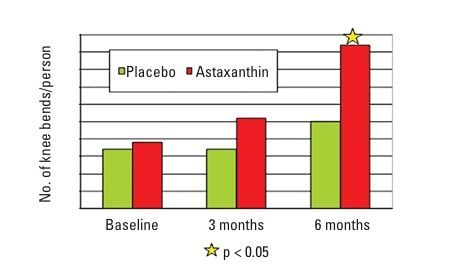
Figure 3: Number of knee bends in healthy young men receiving a placebo or 4 mg of astaxanthin per day10
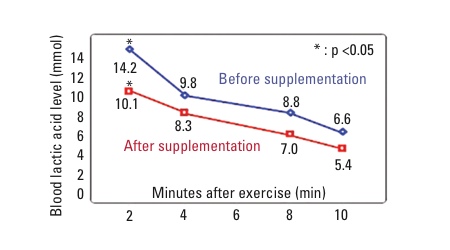
Figure 4: Lactic acid levels after a 1200 m run before and after 4 weeks of astaxanthin intake (4 mg/day)11
In a study looking at the effects of astaxanthin on cycling time trial performance, Earnest et al. tested 21 competitive cyclists after 28 days of supplementation with 0 (placebo) or 4mg of astaxanthin per day. The testing was by no means easy on the subjects and consisted of a 10-hour fast followed by a 2-hour constant intensity pre-exhaustion ride at 5% below VO2 max with lactic acid stimulation.12
After 5 minutes of rest, the participants then began a 20km time trial. The overall results showed significant improvements, with the astaxanthin group reducing their times on average by 121 seconds; the placebo group showed no significant change. A notable increase in power output in the astaxanthin group was also recorded.
The effect of astaxanthin on muscle endurance is further supported by studies on mice. Ikeuchi et al. found that mice supplemented with astaxanthin for five weeks could swim for a significantly longer time before exhaustion compared with the placebo group and those supplemented with other antioxidants (Figure 5).13 In the astaxanthin group, blood lactate concentrations were significantly lower than in the control group. Meanwhile, muscle and liver glycogen were higher in the astaxanthin group.
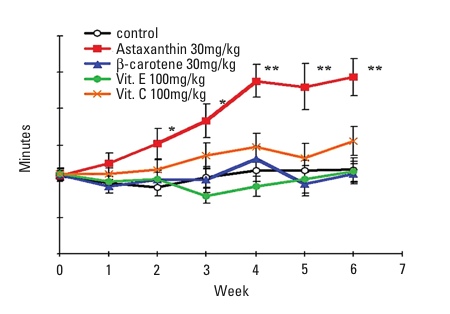
Figure 5: Effect of different antioxidants on swimming time13
These results were reinforced by another study by Aoi et al., which demonstrated comparable results.14 When comparing endurance (running), the total time taken to reach exhaustion for the mice in the astaxanthin group was notably longer than those within the control group. Furthermore, plasma lactate was significantly increased in the control group as a result of exercising, whereas astaxanthin was shown to inhibit the increase of plasma lactate levels. Additionally, astaxanthin increased muscle glycogen and increased fat utilisation (Figure 6). Better fat utilisation during exercise contributes to reduced levels of lactic acid, and also helps with weight loss.

Figure 6: Effect of astaxanthin compared with a placebo in mice on running time (a) and fat utilization (b)13
Astaxanthin increases fat utilisation during exercise
A randomised, double-blind study on humans has confirmed that natural astaxanthin increases fat utilisation during exercise.15 In the study, 32 individuals were supplemented with 2 x 6mg of astaxanthin per day, or placebo, for six weeks. The participants were instructed to undertake 40 minutes of continuous exercise three times per week during the 6-week period. After six weeks, the astaxanthin group had a significant reduction in body fat percentage, whereas there was no difference in the placebo group. These results indicate that astaxanthin increases muscle endurance and reduces lactic acid during intensive training by promoting the use of fat compared with glycogen stores.
Improved quality of RBCs and enhanced mitochondrial function
Respiration is one of the key ways a cell gains useful energy to fuel cellular activity. Aerobic respiration requires oxygen to generate ATP. Insufficient oxygen levels lead to anaerobic metabolism and subsequently result in increased muscle fatigue and lactic acid. In a 2011 randomised, double-blind study on humans, Nakagawa demonstrated that astaxanthin reduces the oxidation of red blood cells (RBCs), suggesting that astaxanthin improves oxygen transportation to muscles.17
In the study, a total of 30 healthy subjects received 0 (placebo), 6 or 12mg of astaxanthin per day during a 12-week period. In the supplemented subjects, both blood plasma and red blood cells showed increased concentrations of astaxanthin. The cell membrane oxidation of RBCs was significantly reduced for both the 6 and 12mg astaxanthin groups compared with that of the placebo group (Figure 7).
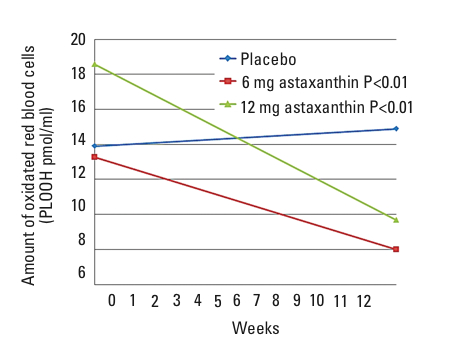
Figure 7: Changes in oxidation of red blood cells before and after 12 weeks of treatment. PLOOH = phospholipid hydroperoxides in the red blood cells16
Furthermore, Wolf et al. demonstrated that astaxanthin stimulates mitochondrial respiration by maintaining a higher membrane diffusion rate, allowing increased oxygen uptake, and improves energy availability to muscles.18 These results indicate that astaxanthin boosts aerobic power by increasing oxygen transportation to muscles and enhancing the capacity of mitochondria.
Reduced oxidation and inflammation in muscles
Not only does astaxanthin protect mitochondria and red blood cells from oxidation, it also protects muscle cells from damage. In a study on mice, it was found that exercise increased oxidation and inflammation in muscles; however, supplementation with natural astaxanthin was shown to significantly lower muscle damage (Figure 8).19 The anti-inflammatory effect of astaxanthin has further been demonstrated by Park et al. in a human study.20 In the randomised, double-blind, placebo-controlled study, 42 subjects were supplemented with 0 (placebo), 2 or 8mg of astaxanthin for an 8-week period. The groups treated with astaxanthin had significantly reduced DNA damage as a result of oxidation and plasma C-reactive protein. According to these results, astaxanthin may lower muscle pain, stiffness and fatigue by reducing inflammation and oxidation in muscles.
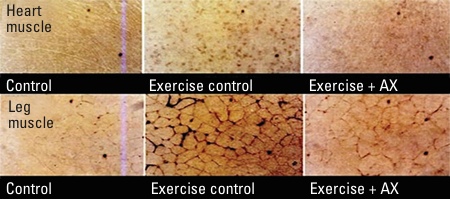
Figure 8: Cross-section of heart and leg muscle. Exercise increased muscle and cell membrane damage (shown in black). Astaxanthin intake reduced muscle damage18
Decreased risk of muscle atrophy
Owing to astaxanthin’s ability to protect muscle cells from damage, it may assist in preventing muscle weakness in ageing. In a study on mice, long-term dietary astaxanthin intake was found to prevent muscle atrophy by reducing oxidative stress and degenerative proteins.21 Forty five week old mice were supplemented with astaxanthin or a placebo for one year. After the treatment period, the soleus muscle weight was significantly higher for the astaxanthin group compared with the placebo group. The levels of degenerative proteins were also significantly lower compared with the placebo group. The results indicate that astaxanthin increases muscle mass by protecting muscle cells from damage. In addition, astaxanthin may prevent muscle atrophy by improving the function of mitochondria, as dysfunction is described as a major factor.3,17
Conclusion
There is growing interest in the power of natural astaxanthin among researchers, and new findings about muscle health and endurance are constantly being published. So far, the research on astaxanthin shows impressive results for muscle health and endurance, owing to its ability to protect cells and membranes from oxidative damage. The results indicate that natural astaxanthin improves muscle endurance and lowers lactic acid by improving fat utilisation, mitochondrial function and by reducing the oxidation of red blood cells and muscle damage.
In addition, studies demonstrate that astaxanthin decreases inflammation, which may reduce muscle pain and potentially prevent muscle atrophy. The effects of astaxanthin have wide appeal as we increasingly recognise the importance of strong, healthy muscles in achieving an active lifestyle and a good quality of life.
References
1. J. Finaud, G. Lac and E. Filaire, Sports Med. 36(4), 327–358 (2006).
2. Y. Tian, et al., Eur. J. Appl. Physiol. 110, 971–976 (2010).
3. R.D. Semba, F. Lauretani and L. Ferrucci, Arch. Biochem. Biophys. 458(2), 141–145 (2007).
4. C. Berzosa, et al., Eur. J. Appl. Physiol. 28(10), 1047–1056 (2010).
5. J. Brzeszczynska, et al., Appl. Physiol. Nutr. Metab. 33(6), 1223–1231 (2008).
6. S. Goto, et al., Biochim. Biophysica. Acta 1512, 251–258 (2001).
7. Y. Nishida, E. Yamashita and W. Miki, Carotenoid Science 11, 16–20 (2007).
8. W. Miki, Pure Appl. Chem. 1(63), 141–146 (1991).
9. H.D. Martin, et al., Pure Appl. Chem. 71(12), 2253–2262 (1999).
10. C.L. Malmsten and Å. Lignell, Carotenoid Science 13, 20–22 (2008).
11. K. Sawaki, et al., Therap. & Med. 18(9), 73–88 (2002).
12. C.P. Earnest, et al., Int. J. Sports Med. 32(11), 882–888 (2011).
13. M. Ikeuchi, et al., Biol. Pharm. Bull. 29(10), 2106–2110 (2006).
14. W. Aoi, et al., Biochem. Biophys. Res. Commun. 366(4), 892–897 (2008).
15. M. Fukamauchi, Food Style 11, 1–4 (2007).
16. M. Ikeuchi, et al., Proceedings of the 21st Annual Meeting on Carotenoid Research (Osaka, Japan, 6–7 September 2007), p 17.
17. K. Nakagawa, et al., Br. J. Nutr. 31, 1–9 (2011).
18. A.M. Wolf, et al., J. Nutr. Biochem. 21(5), 381–389 (2010).
19. W. Aoi, et al., Antioxid. Redox Signal. 5(1), 139–144 (2003).
20. J.S. Park, et al., Nutrition & Metabolism 7, 18 (2010).
21. T. Shibaguchi, et al., Jpn J. Phys. Fitness Sports Med. 57, 541–552 (2008).




